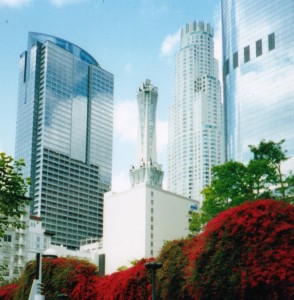LA skyline shows architectural diversity
Downtown Los Angeles might best be described as an urban enigma. It is a relic of a bygone era, as well as a symbol of Los Angeles’ quest to become a more livable and sustainable city. Los Angeles Conservancy’s Modern Skyline Walking Tour helps people conceptualize the city better by exploring the historical context behind the city’s most significant buildings.

Standing tall · The Los Angeles Conservancy offers walking tours of the Downtown LA skyline for a small fee. The tour highlights L.A.’s architectural diversity and the history behind the city’s buildings. – Photo Courtesy of Los Angeles Conservancy
During the tour, guides discuss the process of converting buildings such as the Strand Hotel and Pegasus Apartments from offices to residential uses. Other well-known buildings that are discussed on the tour include the Central Library, the U.S. Bank Tower and the Westin Bonaventure Hotel. The executive director of the Los Angleles Conservancy, Linda Dishman, emphasized that the walking tours spotlight Los Angeles’ architectural diversity.
“Our walking tours support our educational mission in a very significant way,” Dishman said. “People who take our tours get to explore the history of Los Angeles and the unique architectural resources of our city and learn the stories of why these buildings exist. Over 8,000 people took our walking tours last year.”
USC has utilized the tour to show students Los Angeles through a Visions and Voices event, as well as through different departments.
“We would love for USC students to get [more] involved,” Dishman said. “We have volunteer opportunities throughout the year, and students interested in volunteering can fill out our volunteer application on our website.”
Professor Laura Voisin George takes her students on the Skyline Tour as part of her course, PPD 245: “The Urban Context for Policy and Planning.” For George, the walking tour provides an opportunity for her students to experience the tangible results of city planning.
“I wanted [my students] to see some adaptive reuse and how the city has evolved in the past few decades,” George said.
George has a deep appreciation for the work of the conservancy itself. The organization was founded in 1978 in response to the proposed demolition of Los Angeles’ historic Central Library. Since it was founded it has played a significant role in numerous preservation and urban revitalization projects. Particularly, the group has made strides in the last 15 years, through efforts such as the Bringing Back Broadway Initiative. Through its work, the conservancy has become a major player in Downtown’s transition into a vibrant urban center.
“In a city like Los Angeles, there is so much politics involved in all of the decisions that have to do with policies related to historic preservation,” George said. “More so than other [like-minded] organizations, which are focused on education, the Conservancy has to be so connected to political organizations and leaders.”
The conservancy has used its political cachet to help preserve Los Angeles’ most significant historic structures but also to promote neighborhood revitalization.
George and Dishman said that the Adaptive Re-Use Ordinance was an important example of the organization’s role in creating dynamic neighborhoods in historic districts by reusing old buildings.
“In 1999, the conservancy launched our Broadway Initiative which built on the passage of the Adaptive Re-Use Ordinance, which made it easier to convert existing buildings to residential uses,” Dishman said. “The conversion of historic buildings into lofts has had a tremendous impact in not only creating a residential community downtown but also increasing people’s interest in the historic architecture. With more than 14,000 lofts in existing buildings, these residents support restaurants, bars and retail that bring even more people downtown.”
Students can still explore the historical architecture of Los Angeles on Nov. 16th, Dec. 7th and Dec. 21st. Tours take place at 2 p.m. on the first and third Saturdays of each month and cost $10 per person.
Follow us on Twitter @dailytrojan
